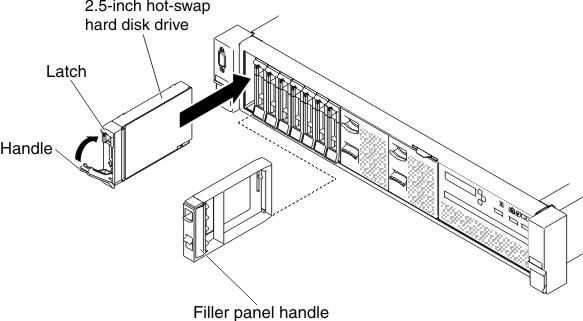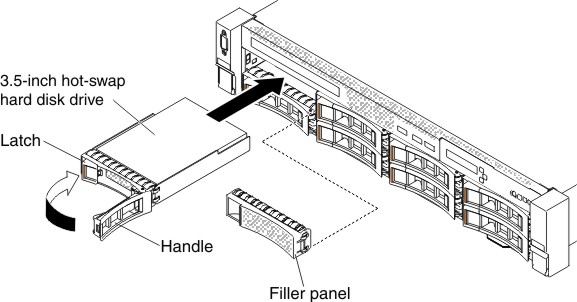Use this information to install a hot-swap hard disk drive.
The following notes describe the type of hard disk drives that the server supports and other information that you must consider when you install a hard disk drive. For a list of supported hard disk drives, see the Lenovo ServerProven website.
- Locate the documentation that comes with the hard disk drive and follow those instructions in addition to the instructions in this chapter.
- As a general consideration, do not mix standard 512-byte and advanced 4-KB format drives in the same RAID array because it may lead to potential performance issues.
- Make sure that you have all the cables and other equipment that are specified in the documentation that comes with the drive.
- Select the bay in which you want to install the drive.
- Check the instructions that come with the drive to determine whether you have to set any switches or jumpers on the drive. If you are installing a SAS or SATA hard disk drive, be sure to set the SAS or SATA ID for that device.
- The hot-swap server models support up to twenty-six 2.5-inch or fourteen 3.5-inch hot-swap SAS or SATA hard disk drives.
- The electromagnetic interference (EMI) integrity and cooling of the server are protected by having all bays and PCI Express slots covered or occupied. When you install a drive or a PCI Express adapter, save the EMC shield and filler panel from the bay or PCI Express adapter slot cover in the event that you later remove the device.
- For a complete list of supported optional devices for the server, see the Lenovo ServerProven website.
To install a hot-swap SAS or SATA hard disk drive, complete
the following steps:
Note: If you have only one hard disk drive, you
must install it in the bay 0 (upper-left).
- Read the safety information that begins on Safety and Installation guidelines.
- Remove the filler panel from the empty drive bay. Keep the filler panel in a safe place.
- Touch the static-protective package that contains the drive to any unpainted metal surface on the server; then, remove the drive from the package and place it on a static-protective surface.
- Install the hard disk drive in the drive bay:
- If you are installing additional hot-swap hard disk drives, do so now.
- Turn on the peripheral devices and the server.

